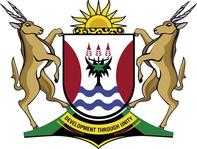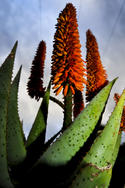The new Coat of Arms for the Eastern Cape Province was granted on March 25, 1996. The arms start with a green base and the motto, DEVELOPMENT THROUGH UNITY. The main element is the Cape Aloe, which symbolises perseverance and strength.

It has three flowers sprouting from a single stem, which shows unity in the province amongst the different groups of people that live there. On either side of the aloe are red flanks, which symbolise the soil. Beneath the aloe is blue waves representing the coastline of the Eastern Cape.
The crest is the sun, symbolising the congenial location and weather found in the Eastern Cape. It signifies the positive attitude and friendliness of the people. Also, the dawning of a new era and bright future of growth, development and prosperity.
Beneath the sun is a leopard print head ring, which is a symbol of prestige, power and heritage of the province. Leopards are perceived to be strong, and across South Africa as a symbol of authority.
Supporting the arms are two eland, the largest of the antelope and widespread throughout the Eastern Cape. In Bushman folklore the eland were revered and an important part of their culture. The eland bull also represents magnificence.
Animal Emblem - Eland (Taurotragus oryx)

The eland is a browser that utilises a wide variety of plant species. The eland’s preferred habitat is semi-arid areas to grasslands and forests. It can survive without water for long periods of time, as it supplements its water requirements from the fruit it eats, especially gemsbok cucumbers and Tsama melons.
The eland also feeds mainly at night and therefore gains moisture from the water droplets that settle on the plants as the temperature drops. Eland are herd animals and protect their young from predators by utilising a nursery for their calves. If threatened by predators, the herd forms a barrier with the larger males on the outside and the calves and females on the inside.
Large bulls are not territorial, as the herd travels far and wide to find food, but they do become possessive and fight over a female in oestrus. Gestation is around 9 months, and the calves are able to run with the herd within hours after birth.
Flower Emblem - Cape Aloe (Aloe ferox)

The Cape aloe is a succulent indigenous to Southern Africa. It is also known as bitter aloe due to its bitter sap. It has been harvested as a medicinal plant for well over 200 years. The sap is renowned as a natural colon cleanser.
The aloe bitters are drained from its cut leaves and used as an effective laxative. Like most medicinal plants, the Cape aloe has other beneficial properties.
Scientific studies show that aloe gel may help to reduce inflammation and increase wound healing. It also shows as having an antiviral, antibacterial and antifungal properties.